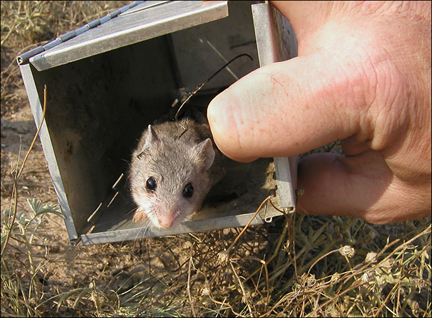Behavioral Ecology of Grasshopper Mice and Deer Mice
 Investigator:
Investigator:
Ron E. VanNimwegen, Ph.D. Student
Project Supervisor:
Dr. Jack Cully
Funding:
Kansas Department of Wildlife and Parks
National Science Foundation / National Institute of Health
Cooperators:
US Forest Service
Cimarron Comanche National Grasslands, SW Kansas
SE Colorado
Completion:
May 2009
Status:
Completed
Mating systems of grasshopper mice: three field seasons of telemetry data are complete (summer 2006 and 2007, winter 2007), and one season remains (summer 2008). To determine the genetic mating system of grasshopper mice, we are developing a microsatellite library from blood and tissue samples to test for extra-pair paternity. Further screening in spring of 2008 and blood sampling in summer 2008 are required. Population-level analyses will be conducted in Fall 2008.
Dispersal patterns of grasshopper mice and deer mice: we have blood and animal samples from 2005-2007, and will complete sampling in summer 2008. The status of microsatellite library development is described above. Measures of relatedness within and among sampled populations will provide relative measures of gene flow between the two species. We will correlate genetic distances with various geographic distances (Euclidean, least-cost, and least-resistance), at two spatial scales: within-grassland and between grasslands (Cimarron and Comanche).
Objectives:
Determine social and genetic mating systems of grasshopper mice
• Estimate home ranges (size, configuration, overlap) of individuals
• Determine extra-pair paternity rates
Determine relative dispersal patterns of grasshopper mice and deer mice
• Calculate genetic distances among sub-populations using microsatellite markers
• Relate genetic distance to geographical distance
Progress and Results:
Analysis of fine-scale movements indicates intra-sexual spacing mechanisms (territoriality) and inter-sexual overlap (pair bonding). Intra-sexual home ranges overlapped to a lesser degree during the breeding season (χ2 = 547, df = 1, P < 0.001), whereas inter-sexual overlap did not differ with season (χ2 = 1.32, df = 1, P = 0.251). Our data support the presence of a socially monogamous mating system, congruent with previous observations from literature. Further sampling is required to increase the statistical power of our initial conclusions. The initial sequencing step of microsatellite development indicates that an adequate number of loci (8-12) can be obtained for further development (primer design, amplification, and screening for allelic variability). Most loci contain di-nucleotide repeats ranging between 5 and 20 base pairs in length, consistent with markers used in studies of closely related mammals. We are seeking funds to finish developing the library, after which population-level analyses will commence.
Products:
Cully, J. F., Jr., S. K. Collinge, R. E. VanNimwegen, C. Ray, W. C. Johnson, B. Thiagarajan, D. B. Conlin, and B. E. Holmes. 2010. Spatial variation in keystone effects: Small mammal diversity associated with black-tailed prairie dog colonies. Ecography 33:667-677.
Cully, J. F., S. K. Collinge, R. E. VanNimwegen, C. Ray, W. C. Johnson, B. Thiagarajan, D. B. Conlin, and B. E. Holmes. 2010. Spatial variation in keystone effects: small mammal diversity associated with black-tailed prairie dog colonies. Ecography 33:1-11.